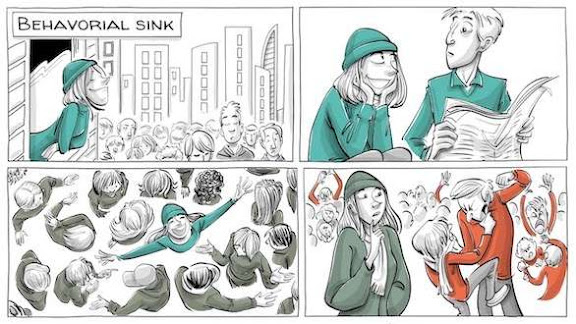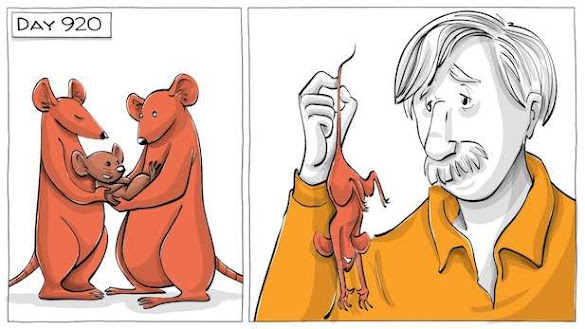Hello, Readers. It has been a long time, but I'm back with an intriguing and thought-provoking topic that will captivate your interest. I had dived into something that could open our eyes and offer a standing glimpse into our future. This topic is rooted in a fascinating experiment conducted in the 1960s, but its implications are startlingly relevant to the world we live in today. After delving deeply into the results of this experiment, I'm convinced that its findings mirror many aspects of our current reality. This experiment not only provides compelling evidence but also aspects of current reality. This experiment provides compelling evidence and challenges us to reflect on where we might be headed.
The Universe 25 experiment was conducted by an American ethnologist John B. Calhoun between the 1960s and 1970s, Mainly the main aim of the experiment was to study the effects of overpopulation on social behavior or we can call it collapse in behavior that can result from overpopulation. The experiment was conducted on mice (Albino rats of Norway) In general Albino rats are used in various biological laboratory experiments due to their close genetic, biological, and psychological processes and similarities to humans, making them useful models for studying human diseases and testing medical treatments.
Through the Universe 25 experiment, scientists wanted to predict the future of humanity. After the experiment's final results, scientists named this phenomenon "Behavioral sink, " identifying the destructive and disturbed behavior in any civilization following a population explosion.
The experiment was named Universe 25 because priorly 24 experiments were already had been conducted before the final 25th one and the shocking fact was all were yielding similar results
I will explain this experiment from two points of view
1. From an actual experiment where the behavior of rats was observed
2. From the behavior of human civilization
Rat-Race but it's not about Rats Actually
1. Construction of the universe 25 enclosure (Rats)
In this, a team of scientists had built a perfect habitat for mice.
Calhoun standing above his mice enclosure in 1961
The enclosure was a 9-foot square with 54-inch high walls. It was provided with unlimited food and water, nesting materials, and a constant comfortable temperature. There were 256 nesting spaces to prevent overcrowding at first. This environment eliminated threats like predators and disease, allowing scientists to focus on how population growth would affect the mice's behavior. The goal was to observe the impact of increasing population density in an ideal living situation.
A suitable environment provided for growth without disturbance
Four pairs of healthy rats are introduced to the enclosure
The enclosure was a 9-foot square with 54-inch high walls. It was provided with unlimited food and water, nesting materials, and a constant comfortable temperature. There were 256 nesting spaces to prevent overcrowding at first. This environment eliminated threats like predators and disease, allowing scientists to focus on how population growth would affect the mice's behavior. The goal was to observe the impact of increasing population density in an ideal living situation.
On the other hand, from the point of view of humans, everything was provided to humans by Mother Nature like food, shelter also a well-suited environment for reproduction, from ancient civilizations or Stone Age humans, humans stand on top among all species in intelligence even with time humans have developed technologies as per their convenience and requirement.
2. Introduction of Mice
In the second step of the experiment. John B. Calhoun introduced four pairs of healthy, fertile mice into the specially designed enclosure. These eight mice were chosen for their good health and reproductive capabilities. They were given time to adjust to their new environment, This adjustment period allowed the mice to explore, establish territories, and start breeding. By starting with a small population, Calhoun aimed to observe how the mice would interact and reproduce in ideal conditions, laying the groundwork for studying the effects of increasing population density.
3. Initial Population Growth (PhaseA)
In the third step of this experiment, the mouse population began to grow rapidly. The ideal enclosure conditions, with unlimited food, water, and nesting materials promoted successful reproduction. As a result, the population doubled approximately every 55 days.
During this phase, the mice displaced normal social behavior, such as establishing territories and forming social hierarchies. This period of rapid population growth and typical social interaction set the stage for later phases when increasing density would begin to impact their behavior.
4. Rapid Population Increase (Phase B)
During Phase B of the Universe 25 experiment, the mouse population continued to grow, reaching 620 by day 315. As the population density increased, signs of social strain began to emerge. Aggressive behavior, Particularly among males, started to appear, disrupting the previously normal social interactions. This phase highlighted the initial impact of overcrowding on the mice's behavior.
Past day 315 over 600 mice lived in Universe 25 resulting in overcrowding & population, eating, drinking, and sleeping rapidly decreased
If we compare it with human life especially today's life in metro cities, similar to densely populated cities where overcrowding strains resources and slow growth, leading to increased competition and stress in daily life
5. Behavioral Sink and Social Decline (Phase C)
In Phase C as the population density increased, social order broke down. Calhoun observed a "behavioral sink,'' where normal behaviors collapsed. Mice showed extreme aggression, social withdrawal, and pathological behaviors. Females struggled with nest-building and caring for their young, leading to higher infant mortality. Some mice, termed "the beautiful ones," isolated themselves, grooming excessively and avoiding social interaction
Similar to challenges observed in densely populated human societies. This parallels issues like increased crime rates, mental health problems, and difficulties in childcare that arise in crowded urban environments. The experiment highlighted how overpopulation can strain social dynamics and mental well-being, offering insights into managing these challenges in human societies.
6. Stagnation and Population Decline (Phase D)
By day 550, population growth slowed in universe 25, peaking at 2,200 rats, below the enclosure's capacity of 3,840. Social dysfunction grew, with no new litters born and a declining population due to reduced reproduction, aggression, and stress. This phase highlighted how social breakdown and stress lead to population decline, reflecting challenges in human societies amid overcrowding and social disintegration.
This is the famous photograph, "The Vulture and the Little Girl" was taken by photographer Kelvin Carter on 26th March 1993 during the "Sudan Famine"
In this image, a little girl is collapsed on foreground due to intense starvation, and a Vulture as a Scavenger behind waiting for her death to make her its food afterward symbolizing the dire consequences of extreme famine and poverty.
7. End of the Experiment
Despite having ample resources, the mouse population continued to decline in the Universe 25 experiment. Social and behavioral recovery proved elusive, leading to eventual extinction. Calhoun concluded that social and behavioral collapse was inevitable in overpopulated conditions, emphasizing that resource availability alone cannot prevent societal breakdown. This stark outcome underscores the challenges of managing populations and social dynamics under extreme conditions of overcrowding.
In conclusion, the Universe 25 experiment warns against the strain of population growth on social structures, highlighting risks of dysfunction and societal collapse, compounded by threats like nuclear conflict.
Play Me!!! 👆
Listen to Me!!!!! 👆
References:- Medawar, P. B. (1946). The definition and measurement of senescence. Proceedings of the Royal Society of Medicine, 39(10), 89-104. Retrieved from
Information used in this blog was obtained from declassified CIA documents through the Freedom of Information Act (FOIA) platform.
Thank You, Readers, for your patience with this blog.
Sources:- Anshul Singh











Sir well explained about human society through the lens of Universe 25 experiment ,it well expressing the current reality of today's human life
ReplyDeleteAll the very Best for your next blogs.
Anshul
ReplyDeleteThis blog is very interesting and you have explained the impact of social strain on today's society in a very simple and easy way through this experimental evidence. Very informative blog...keep going..